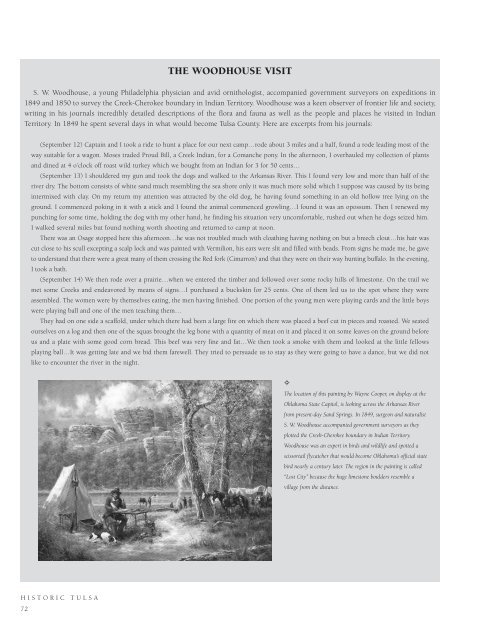Historic Tulsa
An illustrated history of the city of Tulsa, Oklahoma, paired with the histories of companies, families and organizations that make the region great.
An illustrated history of the city of Tulsa, Oklahoma, paired with the histories of companies, families and organizations that make the region great.
Create successful ePaper yourself
Turn your PDF publications into a flip-book with our unique Google optimized e-Paper software.
THE WOODHOUSE VISIT<br />
S. W. Woodhouse, a young Philadelphia physician and avid ornithologist, accompanied government surveyors on expeditions in<br />
1849 and 1850 to survey the Creek-Cherokee boundary in Indian Territory. Woodhouse was a keen observer of frontier life and society,<br />
writing in his journals incredibly detailed descriptions of the flora and fauna as well as the people and places he visited in Indian<br />
Territory. In 1849 he spent several days in what would become <strong>Tulsa</strong> County. Here are excerpts from his journals:<br />
(September 12) Captain and I took a ride to hunt a place for our next camp…rode about 3 miles and a half, found a rode leading most of the<br />
way suitable for a wagon. Moses traded Proud Bill, a Creek Indian, for a Comanche pony. In the afternoon, I overhauled my collection of plants<br />
and dined at 4 o’clock off roast wild turkey which we bought from an Indian for 3 for 50 cents…<br />
(September 13) I shouldered my gun and took the dogs and walked to the Arkansas River. This I found very low and more than half of the<br />
river dry. The bottom consists of white sand much resembling the sea shore only it was much more solid which I suppose was caused by its being<br />
intermixed with clay. On my return my attention was attracted by the old dog, he having found something in an old hollow tree lying on the<br />
ground. I commenced poking in it with a stick and I found the animal commenced growling…I found it was an opossum. Then I renewed my<br />
punching for some time, holding the dog with my other hand, he finding his situation very uncomfortable, rushed out when he dogs seized him.<br />
I walked several miles but found nothing worth shooting and returned to camp at noon.<br />
There was an Osage stopped here this afternoon…he was not troubled much with cloathing having nothing on but a breech clout…his hair was<br />
cut close to his scull excepting a scalp lock and was painted with Vermilion, his ears were slit and filled with beads. From signs he made me, he gave<br />
to understand that there were a great many of them crossing the Red fork (Cimarron) and that they were on their way hunting buffalo. In the evening,<br />
I took a bath.<br />
(September 14) We then rode over a prairie…when we entered the timber and followed over some rocky hills of limestone. On the trail we<br />
met some Creeks and endeavored by means of signs…I purchased a buckskin for 25 cents. One of them led us to the spot where they were<br />
assembled. The women were by themselves eating, the men having finished. One portion of the young men were playing cards and the little boys<br />
were playing ball and one of the men teaching them…<br />
They had on one side a scaffold, under which there had been a large fire on which there was placed a beef cut in pieces and roasted. We seated<br />
ourselves on a log and then one of the squas brought the leg bone with a quantity of meat on it and placed it on some leaves on the ground before<br />
us and a plate with some good corn bread. This beef was very fine and fat…We then took a smoke with them and looked at the little fellows<br />
playing ball…It was getting late and we bid them farewell. They tried to persuade us to stay as they were going to have a dance, but we did not<br />
like to encounter the river in the night.<br />
✧<br />
The location of this painting by Wayne Cooper, on display at the<br />
Oklahoma State Capitol, is looking across the Arkansas River<br />
from present-day Sand Springs. In 1849, surgeon and naturalist<br />
S. W. Woodhouse accompanied government surveyors as they<br />
plotted the Creek-Cherokee boundary in Indian Territory.<br />
Woodhouse was an expert in birds and wildlife and spotted a<br />
scissortail flycatcher that would become Oklahoma’s official state<br />
bird nearly a century later. The region in the painting is called<br />
“Lost City” because the huge limestone boulders resemble a<br />
village from the distance.<br />
HISTORIC TULSA<br />
72
















